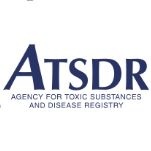The Agency for Toxic Substances and Disease Registry (ATSDR) is a federal public health agency under the umbrella of the Centers for Disease Control (CDC) based in Atlanta, Georgia. The agency's mission is to prevent harm to human health and diminished quality of life from exposure to hazardous substances found at waste sites, in unplanned releases, and in other sources of pollution present in the environment. ATSDR identifies communities where people might be exposed to hazardous substances in the environment, but as far as investigations go, ATSDR cannot enforce any regulations by closing down a plant or other business, it can only make recommendations to the U.S. Environmental Protection Agency. The ATSDR has worked on a variety of different cases and projects, including aiding New York City in establishing a registry to assess short and long term health effects from the World Trade Center collapse, sampling the dust and air after the collapse of the World Trade Center, testing the water and soil at Camp Pendleton for lead, copper and other chemicals, as well as monitoring the effects of asbestos and identifying sites that have high concentrations of it.
The discovery of contamination in New York State’s Love Canal during the 1970s first brought the problem of hazardous wastes to national attention. Similarly, the health threat from sudden chemical releases came into focus in December 1984, when a cloud of methyl isocyanate gas released from a Union Carbide facility in Bhopal, India, killed approximately 8,000 people and permanently disabled another 50,000. The Comprehensive Environmental Response, Compensation, and Liability Act (CERCLA), commonly known as Superfund, was enacted by Congress on December 11, 1980. This law created a tax on the chemical and petroleum industries and provided broad Federal authority to respond directly to releases or threatened releases of hazardous substances that could endanger public health or the environment.
- Helped thousands of returning residents in Mississippi and Louisiana re-enter their homes safely following Hurricanes Katrina and Rita; (see controversies)
- Advanced asthma research through a study in New York that found a link between exposures to particulate matter, sulfur dioxide, ozone, nitrous oxide, and other pollutants with asthma emergency department visits;
- Helped stop mercury exposures to preschool children at a Franklin Township, New Jersey, day-care center run for two years in a building once occupied by a medical instruments manufacturer; and
- Protected the health of people in Connecticut and Indiana living near chemical facilities that caught fire by helping to ensure safe cleanup and re-occupancy.
Internet HazDat Data Dictionary
Public Health Assessment: Hipps Road Landfill Jacksonville, Duval County, Florida
- Table of Contents
- Overview
- History
- What it Does
- Where Does the Money Go
- Controversies
- Suggested Reforms
- Comments
- Leave a comment


Frumkin has served on the board of directors of Physicians for Social Responsibility, as president of the Association of Occupational and Environmental Clinics and as chair of the Science Board of the American Public Health Association. He has also served as a consultant to several corporations, including Hewlett-Packard, Southwire, Georgia Power, and Polaroid, and to several unions, including the Chemical Workers Association and the Utility Workers Union.
- Latest News
- D.C. Public Schools will Teach all Second-Graders to Ride a Bike
- New Rule in Germany Limits Sales of Sex-Themed E-Books to 10pm to 6am
- What Happened to the 6-Year-Old Tibetan Boy the Chinese Government Kidnapped 20 Years Ago?
- U.S. Ambassador to Turkey Photoshops his Hair Color to Mock Turkish Mayor
- Mystery Artist Calls Attention to Unfixed Potholes by Drawing Penises around Them
The Agency for Toxic Substances and Disease Registry (ATSDR) is a federal public health agency under the umbrella of the Centers for Disease Control (CDC) based in Atlanta, Georgia. The agency's mission is to prevent harm to human health and diminished quality of life from exposure to hazardous substances found at waste sites, in unplanned releases, and in other sources of pollution present in the environment. ATSDR identifies communities where people might be exposed to hazardous substances in the environment, but as far as investigations go, ATSDR cannot enforce any regulations by closing down a plant or other business, it can only make recommendations to the U.S. Environmental Protection Agency. The ATSDR has worked on a variety of different cases and projects, including aiding New York City in establishing a registry to assess short and long term health effects from the World Trade Center collapse, sampling the dust and air after the collapse of the World Trade Center, testing the water and soil at Camp Pendleton for lead, copper and other chemicals, as well as monitoring the effects of asbestos and identifying sites that have high concentrations of it.
The discovery of contamination in New York State’s Love Canal during the 1970s first brought the problem of hazardous wastes to national attention. Similarly, the health threat from sudden chemical releases came into focus in December 1984, when a cloud of methyl isocyanate gas released from a Union Carbide facility in Bhopal, India, killed approximately 8,000 people and permanently disabled another 50,000. The Comprehensive Environmental Response, Compensation, and Liability Act (CERCLA), commonly known as Superfund, was enacted by Congress on December 11, 1980. This law created a tax on the chemical and petroleum industries and provided broad Federal authority to respond directly to releases or threatened releases of hazardous substances that could endanger public health or the environment.
- Helped thousands of returning residents in Mississippi and Louisiana re-enter their homes safely following Hurricanes Katrina and Rita; (see controversies)
- Advanced asthma research through a study in New York that found a link between exposures to particulate matter, sulfur dioxide, ozone, nitrous oxide, and other pollutants with asthma emergency department visits;
- Helped stop mercury exposures to preschool children at a Franklin Township, New Jersey, day-care center run for two years in a building once occupied by a medical instruments manufacturer; and
- Protected the health of people in Connecticut and Indiana living near chemical facilities that caught fire by helping to ensure safe cleanup and re-occupancy.
Internet HazDat Data Dictionary
Public Health Assessment: Hipps Road Landfill Jacksonville, Duval County, Florida
Comments


Frumkin has served on the board of directors of Physicians for Social Responsibility, as president of the Association of Occupational and Environmental Clinics and as chair of the Science Board of the American Public Health Association. He has also served as a consultant to several corporations, including Hewlett-Packard, Southwire, Georgia Power, and Polaroid, and to several unions, including the Chemical Workers Association and the Utility Workers Union.
- Latest News
- D.C. Public Schools will Teach all Second-Graders to Ride a Bike
- New Rule in Germany Limits Sales of Sex-Themed E-Books to 10pm to 6am
- What Happened to the 6-Year-Old Tibetan Boy the Chinese Government Kidnapped 20 Years Ago?
- U.S. Ambassador to Turkey Photoshops his Hair Color to Mock Turkish Mayor
- Mystery Artist Calls Attention to Unfixed Potholes by Drawing Penises around Them






Comments